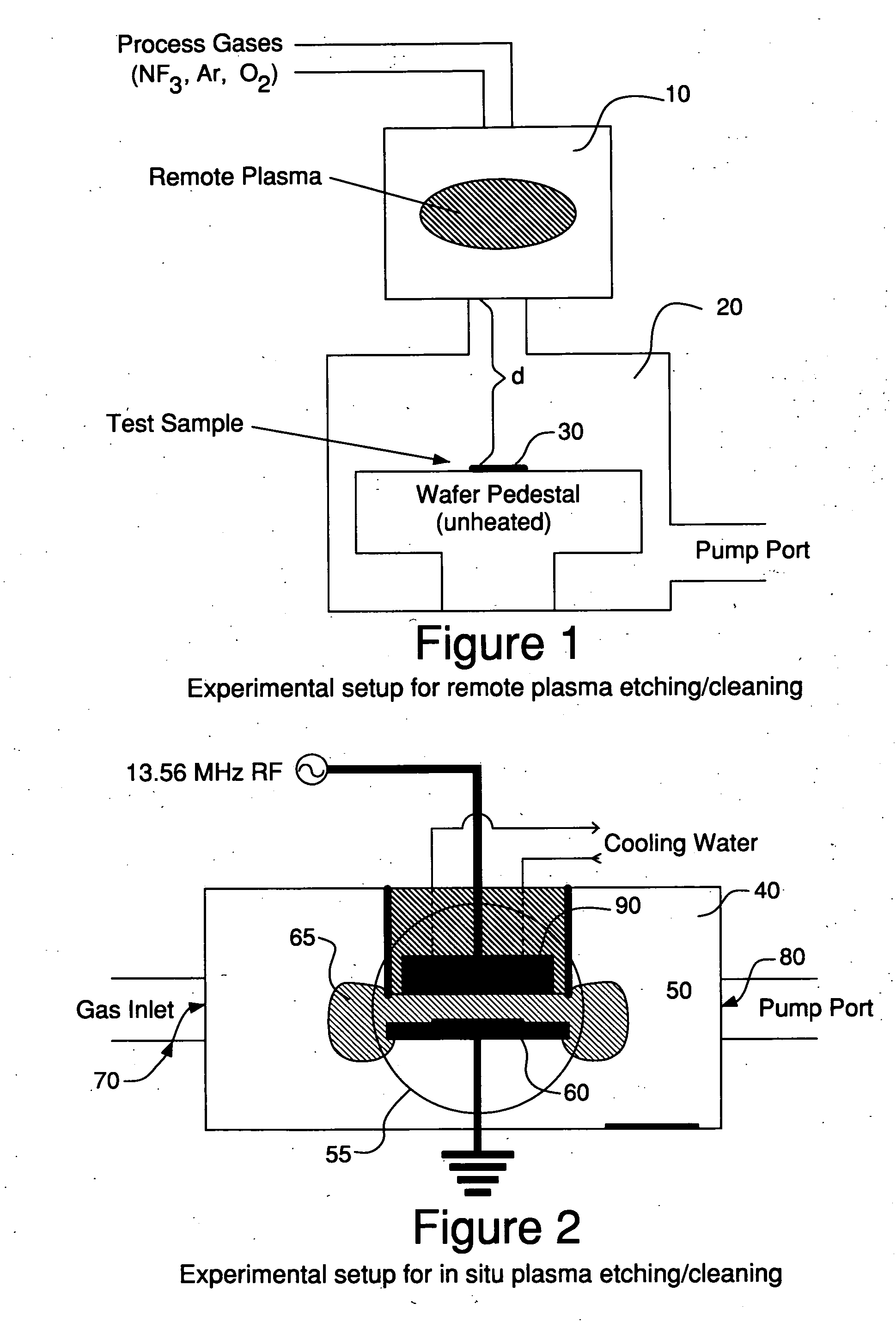Removal of transition metal ternary and/or quaternary barrier materials from a substrate
a technology of ternary and/or quaternary barrier materials and transition metals, which is applied in the direction of coatings, chemical vapor deposition coatings, semiconductor devices, etc., can solve the problems of particle shedding, processing drift, and reaction that forms these films also occur non-productively on other exposed surfaces inside the processing chamber
- Summary
- Abstract
- Description
- Claims
- Application Information
AI Technical Summary
Problems solved by technology
Method used
Image
Examples
example 1
Remote Plasma Cleaning of Ternary Tungsten Nitride Carbide (WNxCy) Materials
[0040]FIG. 1 provides an illustration of the experimental setup for remote plasma cleaning. An ASTRON® remote plasma generator 10 manufactured by MKS Instruments of Wilmington, Mass. was mounted on top of process chamber 20. The distance “d” between the exit of remote plasma generator 10 and the sample coupon 30 is about six inches. Table 1 lists the experiment recipes and WNxCy etch rates. In all of the runs, the chamber pressure was kept at 4 Torr. The thickness of the tungsten nitride carbide layer on the sample coupon is about 90 nm.
[0041] Each run was conducted in the following manner: vent chamber and open front door; load sample coupons and close front door; evacuate chamber to reach baseline vacuum pressure; introduce argon (Ar) gas and stabilize pressure; turn on the remote plasma power; introduce process gases; turn off the remote plasma power after 1 minute; stop process flows and evacuate chamb...
example 2
In Situ Plasma Cleaning of WNxCy
[0042]FIG. 2 provides an illustration of the experimental setup for in situ plasma cleaning of WNxCy. The experiments were run in a capacitively coupled parallel plate process chamber 40. The gap spacing between the two electrodes was one inch. A sample coupon 50 was placed on the center of the grounded lower electrode 60 so that it is in direct contact with the plasma. There is no dc self-bias voltage and no RF driven voltage at grounded electrode and chamber walls. Process gases were introduced from a side port 70 and pumped out through another port 80 on the opposite side of the chamber. RF power was applied to the top electrode 90, which was water cooled at 20° C. The thickness of the tungsten nitride carbide layer on the sample coupon is about 20 nm.
[0043] Each run was conducted in the following manner: process chamber 40 was loaded with sample coupons 50 and sample loading door 55 was closed. Chamber 40 was evacuated to reach baseline vacuum p...
example 3
Thermal NF3 Cleaning of WNxCy
[0046]FIG. 4 is a schematic diagram of the experimental setup for thermal clean of WNxCy sample coupons. This process chamber 100 was modified from the in situ plasma process chamber 40 shown in FIG. 2. The sample coupon 110 was placed on a 4 inch carrier wafer 120, which was placed on a heated pedestal 130. Other aspects of the process chamber design were similar to those described in FIG. 2. After the introduction of the sample coupon and evacuation of the process chamber, the pedestal and the sample coupon was heated by a resistive heater to reach a preset temperature. A process gas 140 containing the fluorine-containing gas NF3 was then fed into the process chamber 100 to reach a preset chamber pressure to remove the WNxCy film from the sample coupon 110. The sample coupons were measured by spectroscopic ellipsometer before and after the processing. The thickness of the tungsten nitride carbide layer on the sample coupon is about 20 nm. Table 2 list...
PUM
| Property | Measurement | Unit |
|---|---|---|
| thickness | aaaaa | aaaaa |
| thickness | aaaaa | aaaaa |
| temperature | aaaaa | aaaaa |
Abstract
Description
Claims
Application Information
 Login to View More
Login to View More - R&D
- Intellectual Property
- Life Sciences
- Materials
- Tech Scout
- Unparalleled Data Quality
- Higher Quality Content
- 60% Fewer Hallucinations
Browse by: Latest US Patents, China's latest patents, Technical Efficacy Thesaurus, Application Domain, Technology Topic, Popular Technical Reports.
© 2025 PatSnap. All rights reserved.Legal|Privacy policy|Modern Slavery Act Transparency Statement|Sitemap|About US| Contact US: help@patsnap.com



